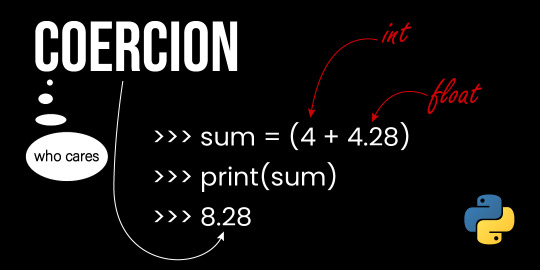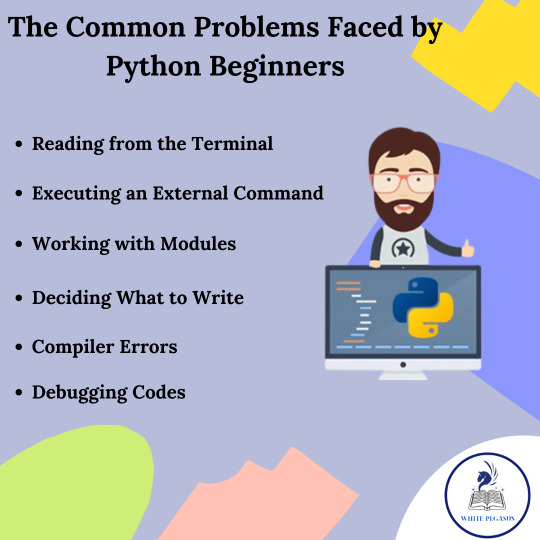#pythonbeginners
Explore tagged Tumblr posts
Text
How to Learn Python from Scratch in 2025: A Beginner’s Guide
Python continues to be one of the most in-demand and beginner-friendly programming languages in 2025. Whether you're a student, aspiring developer, or working professional looking to upskill, learning Python from scratch is easier than ever — if you follow the right roadmap.
🎯 Step 1: Understand Why You’re Learning Python
Are you aiming for data science, web development, automation, or AI? Knowing your goal helps you stay focused and choose the right path. Python is versatile, so you can start simple and expand into your area of interest.
📚 Step 2: Start with the Basics
Begin with core Python concepts like:
Variables and Data Types
Loops and Conditionals
Functions and Modules
Lists, Tuples, and Dictionaries Use beginner platforms like W3Schools, Codecademy, or free YouTube tutorials. Practice as you go — don’t just read or watch.
💻 Step 3: Install Python and Use an IDE
Download the latest Python version from python.org. Use beginner-friendly IDEs like Thonny or VS Code. Try writing small scripts like a calculator, number guesser, or basic chatbot.
🧠 Step 4: Practice Every Day
Use platforms like HackerRank, LeetCode, or Replit to practice coding daily. Aim for 30–60 minutes of hands-on coding. Solving problems builds logic and confidence.
📊 Step 5: Learn by Building Projects
Apply what you learn by creating small projects like:
To-do app
Weather app using APIs
Simple games with Pygame Building helps reinforce concepts and improves your portfolio.
👨🏫 Step 6: Get Expert Help When Stuck
If you're struggling with assignments or need personalized guidance, reach out to experts at AllHomeworkAssignments.com. They offer reliable help for Python coding, debugging, and project development.
🧭 Final Thoughts
Python is easy to learn but requires consistency. With clear goals, daily practice, and the right resources, you’ll be writing powerful Python programs in no time. Start small, stay steady, and you’ll master Python from scratch in 2025.
#LearnPython2025#PythonBeginners#CodingFromScratch#PythonForStudents#AllHomeworkAssignments#PythonProgrammingHelp#PythonProjects
1 note
·
View note
Text
How Does Python Support Web and AI Development?
Python plays a vital role in both web and AI development due to its simplicity, versatility, and vast ecosystem of libraries and frameworks. In web development, Python offers powerful frameworks like Django and Flask, which allow developers to build scalable, secure, and maintainable web applications with minimal code. These frameworks come with built-in tools for handling databases, user authentication, URL routing, and more, speeding up the development process.
For AI development, Python is the go-to language thanks to libraries such as TensorFlow, PyTorch, scikit-learn, and Keras. These tools simplify complex tasks like deep learning, natural language processing (NLP), and machine learning (ML) model building. Python's readable syntax and extensive documentation make it accessible even for those new to coding, while its active community ensures regular updates and support.
Python also integrates well with data analysis tools like Pandas and NumPy, making it easy to preprocess and analyze data an essential step in AI workflows. Whether you’re building a chatbot, recommendation system, or a predictive model, Python offers the tools and flexibility needed.
To begin your journey into these fields, consider enrolling in a Python course for beginners.
0 notes
Text
Explore the best computer courses for beginners in 2025 and build strong tech skills with TCCI’s expert guidance and hands-on training.
0 notes
Text
Learning Python, Fourth Edition" by Mark Lutz is a comprehensive guide for anyone looking to master Python, one of the most versatile and widely-used programming languages. Whether you're a beginner or an experienced developer, this book provides a deep dive into Python's core concepts, advanced features, and practical applications. Below is a step-by-step breakdown of the outcomes you can expect after reading this book, presented in a user-friendly manner:
#LearningPython#Python#PythonProgramming#Python3#PythonTutorial#PythonDevelopment#SoftwareDevelopment#PythonBeginners#PythonLearning#TechBooks#PythonResources#PythonCode#PythonCommunity#PythonSkills#ProgrammingBooks#PythonTips#PythonFundamentals#Coding#TechEducation#PythonProjects#PythonExperts#LearningResources#SoftwareEngineering#PythonBook#ProgrammingForBeginners
0 notes
Text
🐍 How to Learn Python for Bioinformatics? A Beginner’s Guide 🔬💻
Python is one of the most powerful and beginner-friendly programming languages for bioinformatics, making it essential for analyzing genomic data, automating workflows, and developing computational biology tools. If you're from a biotech or life sciences background and want to transition into bioinformatics, learning Python is the perfect first step!
Here’s a step-by-step guide to mastering Python for Bioinformatics from scratch. 🚀
📌 Step 1: Learn Python Basics
Before diving into bioinformatics-specific applications, build a strong foundation in Python programming. Start with:
✅ Basic Syntax – Variables, loops, conditionals ✅ Functions & Modules – Code reusability in Python ✅ Data Structures – Lists, dictionaries, tuples ✅ File Handling – Reading and writing biological data
📚 Best Free Courses to Start:
Python for Beginners – CS50 (Harvard) edX
Python Crash Course W3Schools
Automate the Boring Stuff with Python Udemy
📌 Step 2: Get Comfortable with Bioinformatics Libraries
Once you're comfortable with Python basics, start using bioinformatics-specific libraries to process biological data.
🔬 Key Libraries for Bioinformatics: ✅ Biopython – Sequence analysis, BLAST, FASTA/FASTQ file handling ✅ Pandas – Managing large biological datasets ✅ NumPy – Handling genetic sequence arrays ✅ Matplotlib & Seaborn – Data visualization for bioinformatics ✅ Scikit-learn – Machine learning for genomic analysis
🖥️ Try This Beginner Exercise: Download a FASTA file and use Biopython to parse and analyze a DNA sequence.
from Bio import SeqIO
# Read a FASTA file
for seq_record in SeqIO.parse("example.fasta", "fasta"): print(f"Sequence ID: {seq_record.id}")
print(f"Sequence: {seq_record.seq}")
print(f"Length: {len(seq_record.seq)}")
🔗 Best Resources for Learning BioPython:
Biopython Cookbook Official Docs
Intro to Biopython Course Datacamp
📌 Step 3: Work on Real Bioinformatics Projects
The best way to learn is through hands-on projects. Here are some beginner-friendly projects:
🧬 Project Ideas for Bioinformatics Beginners: ✅ DNA Sequence Analysis – Find GC content, transcription, and reverse complement. ✅ BLAST Automation – Write Python scripts to automate BLAST searches. ✅ Genome Data Visualization – Plot gene expression data using Matplotlib. ✅ Mutation Analysis – Identify and categorize SNPs in genomic sequences. ✅ Machine Learning in Bioinformatics – Train models for disease prediction.
📚 Practice with Real Datasets:
NCBI GenBank (ncbi.nlm.nih.gov)
ENSEMBL Genome Browser (ensembl.org)
Kaggle Bioinformatics Datasets (kaggle.com)
📌 Step 4: Join the Bioinformatics Community
Engaging with other bioinformatics learners and experts will keep you motivated and up to date.
🌎 Top Bioinformatics Communities: 💬 Biostars – biostars.org (Q&A forum for bioinformatics) 💻 Reddit – r/bioinformatics for discussions and resources 📢 Twitter/X – Follow researchers using #Bioinformatics #CompBio
📌 Step 5: Enroll in Online Courses & Certifications
Once you have some hands-on experience, take structured courses to solidify your knowledge.
📚 Best Courses for Python & Bioinformatics:
Bioinformatics Specialization – Coursera (UC San Diego)
Python for Genomic Data Science – Coursera (Johns Hopkins)
Bioinformatics with Python – BioPractify (biopractify.in)
🚀 Final Thoughts: Start Learning Today!
Python is revolutionizing bioinformatics, and learning it doesn’t require a programming background! Start with Python basics, explore bioinformatics libraries, work on real projects, and engage with the community. With consistent effort, you’ll be analyzing genomic data in no time!
📢 Are you learning Python for bioinformatics? Share your journey in the comments! 👇✨
#PythonForBioinformatics#Bioinformatics#ComputationalBiology#Genomics#MachineLearning#PythonProgramming#Biopython#GenomicData#BioinformaticsTools#BioTechCareers#CodingForBiologists#STEM#PythonBeginners#GenomeAnalysis#DataScience
1 note
·
View note
Video
Python Students Beginners Group Discussion | Python Interview Preparatio...
#youtube#Python Coding Programming InterviewPreparation LearnPython PythonBeginners PythonCoding InterviewTips CodeNewbie TechCommunity PythonProgram
0 notes
Text
Python Ternary Operator
Visit our site for free project source codes-- dailyaspirants.com . . Follow @dailyaspirants for more content on website development, programming languages like Python, PHP, SEO, Free tools..etc.
#pythonhub#pythonprogramming#python3#programming#pythonprojects#pythonbeginner#coding#chatgpt#AI#codingforkids#CodingisFun#codinglife#html#html5#css#Code#dailyaspirants#numpy
0 notes
Photo

@letstacle #pythonprojects for beginners @letstacle Follow @letstacle #pythonbeginner #pythonbeginners #pythonprojects #pythonlover #pythonlanguage #pythonlovers🐍 #coderslife #codingisfun #codingbeginner #softwaredevelopment #programmingpython #webdesign #codingforgirls #comment4comment #followforfollowback #computerscience #lovepythons https://www.instagram.com/p/COpB5R5HYRx/?igshid=1h1vro4mrmyzf
#pythonprojects#pythonbeginner#pythonbeginners#pythonlover#pythonlanguage#pythonlovers🐍#coderslife#codingisfun#codingbeginner#softwaredevelopment#programmingpython#webdesign#codingforgirls#comment4comment#followforfollowback#computerscience#lovepythons
1 note
·
View note
Text
Coercion / python

During an operation with two arguments of the same type, the implicit conversion of one type's instance to another. For example, int(4.28) converts a floating point number to an integer 4.
in[] x = int(4.28) print(x) out[] 4
But in 4+2.8, each argument is of a different type (one int, one float), and both must be converted to the same type before they can be added, or a TypeError is raised. Without coercion, the programmer would have to normalize all arguments, even those of compatible types, to the same value, e.g., float(4)+4.5 instead of just 4+2.8.
in[] sum = (4 + 4.28) print(sum) out[] 8.28
1 note
·
View note
Photo

The Common Problems Faced by Python Beginners
• Reading from the Terminal • Executing an External Command • Working with Modules • Deciding What to Write • Compiler Errors • Debugging Codes
Learn More
0 notes
Photo

HEY!!!!!! REPUBLIC DAY SALE IS ON!!!! Learn PYTHON from Basics to advanced topics.Learn python GUI,Python Data Analysis and many more topics. Learn Python programming and become a Python Cracker.Interested people can share me your details. Inbox me your details. Check our Info : www.incegna.com Reg Link for Programs : http://www.incegna.com/contact-us Follow us on Facebook : www.facebook.com/INCEGNA/? Follow us on Instagram : https://www.instagram.com/_incegna/ For Queries : [email protected] #python,#pythonprogrammers,#pythondataanalysis,#machinelearningpythonprogrammmers,#pythonmodules,#MatPlotLib,#Seleniu,#artificialintelligence,#pythonbeginners,#oopsinpython,#java,#Datascience,#datascientist https://www.instagram.com/p/B7u9N4ggAW3/?igshid=wqbeneug29k0
#python#pythonprogrammers#pythondataanalysis#machinelearningpythonprogrammmers#pythonmodules#matplotlib#seleniu#artificialintelligence#pythonbeginners#oopsinpython#java#datascience#datascientist
0 notes
Photo

Python and Web Development Classes for Beginners at an affordable fee of 700-1500 INR. Classes will be 3 times a week with a doubt session every alternate week.
8 notes
·
View notes
Photo

Python Beginner Topics | InsideAIML Insideaiml is one of the best platforms where you can learn Python, Data Science, Machine Learning, Artificial Intelligence & showcase your knowledge to the outside world.
1 note
·
View note
Text
Program for getting information on user input in HTML
Visit our site for free project source codes-- dailyaspirants.com . . Follow @dailyaspirants for more content on website development, programming languages like Python, PHP, SEO, Free tools..etc.
#pythonhub#pythonprogramming#python3#programming#pythonprojects#pythonbeginner#coding#chatgpt#AI#codingforkids#CodingisFun#codinglife#html#html5#css#Code#dailyaspirants#numpy
0 notes
Text

Start Your Coding Journey with Python – The Language of the Future! 🐍💻 Want to step into the world of programming? Python is the perfect place to begin! Known for its simplicity, readability, and versatility, Python is widely used in web development, data science, AI, machine learning, automation, and more. 🚀 Whether you're a complete beginner or looking to sharpen your skills, learning Python opens the door to endless opportunities. From building real-world projects to solving complex problems, Python helps you think logically and code smartly. 💡 Join the global community of Python developers and future-proof your career today. The best part? It’s fun, easy to learn, and in high demand!
🔥 Start learning now and turn your ideas into reality with Python!
#PythonProgramming #LearnToCode #CodingLife #PythonBeginners #ProgrammingInPython #TechSkills #CodeNewbie #DeveloperLife #AutomationWithPython #DataScience #MachineLearning #PythonProjects #CodingIsFun #FutureWithPython #TechJourney
0 notes
Text
0 notes